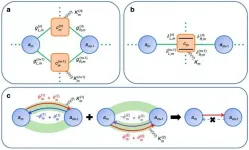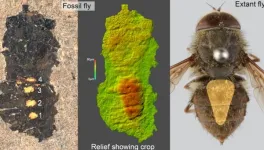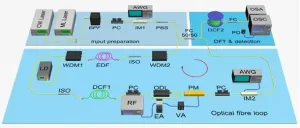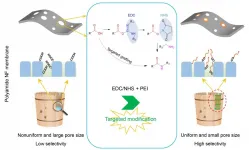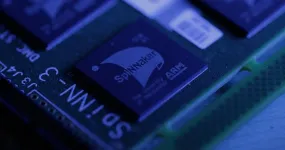(Press-News.org) Optical nonreciprocity, which prohibits the light field returning along the original path after passing through the optical system in one direction, is not only of vast interest to fundamental science, which brings us a deeper understanding of Lorentz reciprocity, time-reversal symmetry, and topological effects, but is also of great importance for realizing nonreciprocal optical and electromagnetics devices such as isolators, circulator and directional amplifiers, which are indispensable for applications ranging from optical communication to optical information processing.
However, realizing nonreciprocity is rather difficult as it requires breaking of the Lorentz reciprocity theorem. In other words, the protocols to nonreciprocity generation are limited as a result of the time-reversal symmetry and linear property of Maxwell's equations. Most of the existing approaches to realize nonreciprocity can be grouped into three categories with the following requirements: (i) magnetic field induced breaking of time-reversal asymmetry, (ii) spatiotemporal modulation of system permittivity; (iii) nonlinearity. Nevertheless, these principles either meets difficulties for integration, or requires stringent experimental conditions, or has limited performances.
In a new paper published in Light Science & Application, a team of scientists, led by Professor Yong-Chun Liu from State Key Laboratory of Low-Dimensional Quantum Physics, Department of Physics, Tsinghua University, China, and co-workers have proposed a new principle to realize nonreciprocity by going beyond the existing three categories of approaches. The idea is using energy loss to induce nonreciprocity. The loss in a resonance mode induces a phase lag, which is independent of the energy transmission direction. By combining multichannel lossy resonance modes, the interference gives rise to nonreciprocity, with different coupling strength for forward and backward directions [Fig. 1].
For the completely nonreciprocal points, i.e., the coupling only exists in one direction, the eigenvalues of the system are degenerate, accompanied by the coalescence of the eigenmodes, which present the features of the exceptional points.
The unidirectional nonreciprocal coupling directly gives rise to the unidirectional energy transmission between the main resonance modes. [Fig. 2].
In the scheme, magnetic field, nonlinearity and spatiotemporal modulation of permittivity are all not required. On the contrary, simply energy loss is used, which exists ubiquitously in a variety of physical systems, and is regarded as harmful and undesirable in most studies. The scheme is advantageous since it works for pure lossy and linear systems, in which neither gain nor nonlinearity is required.
The scheme is generic and can be applied to a variety of systems, such as optical cavities and waveguides, mechanical resonators, atomic ensembles, as well as superconducting circuits. This research paves the way for the design of nonreciprocal devices and the study of topological properties in lossy systems, without stringent requirements.
INFORMATION:
Looking at the night sky, one's thoughts might be drawn to astrochemistry. What molecules inhabit the vast spaces between the stars? Would we see the same molecules that surround us here on Earth? Or would some of them be more exotic--something rarely observed or even unknown?
Recent research by a multinational team led by Prof. Robert Ko?os from the Institute of Physical Chemistry of the Polish Academy of Sciences has revealed an unusual molecule obtained and detected for the first time in laboratory conditions and also paved a smooth path to produce and further study another. Now that they can be seen and studied, they may prove worthy ...
Until now, it was only possible to optimize an acoustic cloaking structure for the air-environment. However, with this latest research, Acoustic cloak designed by topology optimization for acoustic-elastic coupled systems, published in the latest Applied Physics Letters, it is possible to design an acoustic cloak for underwater environments.
In the conventional topology optimization of acoustic cloaking, the design method was based on an analysis that approximated an elastic body in the air as a rigid body. However, since the approximation holds only for materials that are sufficiently ...
Two types of materials are better than one when it comes to solar cells, as revealed by an international team that has tested a new combination of materials and architecture to improve solar-cell efficiency.
Silicon has long dominated as the premier material for solar cells, helped by its abundance as a raw material. However, perovskites, a class of hybrid organic-inorganic material, are a viable alternative due to their low-cost and large-scale manufacture and potentially higher performance. While still too unstable for full commercialization, they might become available to the market by 2022.
KAUST's Michele ...
It was not the fly itself that caught the scientists' attention, but its bulging abdomen suggesting it was still full with the fly's last food intake. Surprisingly, analysis of the stomach content revealed it was full with pollen from different plants. The fossil pollen from the fly's stomach was used to reconstruct the ancient environment inhabited by the fly, the biotic interactions between plant and fly, and the fly's behaviour during feeding.
Flies as pollinators
Today, bees, butterflies and bumblebees are the typical pollinators, which are also known to feed on pollen. That flies also play an important role in pollination ...
BOs describe the periodic movement of electrons in solids to which an external static electric field is applied. However, it is challenging to measure the BOs directly in natural solids since the relaxation time of electrons is usually much shorter than the oscillation period. To date, analogies of electron BOs have been extended to the synthetic dimensions of time, frequency and angular momenta. In previous studies, the frequency BOs have been experimentally demonstrated in a nonlinear fibre with cross-phase modulation. However, the frequency spectrum has ...
An innovative analysis of two-dimensional (2D) materials from engineers at the University of Surrey could boost the development of next-generation solar cells and LEDs.
Three-dimensional perovskites have proved themselves remarkably successful materials for LED devices and solar panels in the past decade. One key issue with these materials, however, is their stability, with device performance decreasing quicker than other state-of-the-art materials. The engineering community believes the 2D variant of perovskites could provide answers to these performance issues.
In a study published in The Journal of Physical Chemistry Letters, researchers from Surrey's Advanced Technology Institute (ATI) detail how to improve the physical properties of 2D perovskite called Ruddlesden-Popper.
The study ...
Recently, a research group led by Prof. WAN Yinhua from the Institute of Process Engineering (IPE) of the Chinese Academy of Sciences developed a novel targeted modification strategy to improve the separation selectivity of polyamide NF membranes.
The study was published in Journal of Membrane Science on March 10.
The low selectivity of commercial nanofiltration (NF) membranes to monosaccharides and monovalent salts is mainly due to the nonuniform pore size distribution and strong electronegativity.
Targeted modification can regulate the pore size distribution and electronegativity of polyamide NF membranes, and thus improve the separation selectivity.
In the strategy, carboxyl groups (-COOH) on the surface are activated by N-(3-Dimethylaminopropyl)-N'-ethyl ...
An international collaboration headed by researchers from iPSYCH has found genetic variants that increase the risk of aggression in children with ADHD. In the same study, the researchers also discovered that the genetics which increase aggression in some children with ADHD, are the same genetics that affect aggression in children without a diagnosis.
For the first time, researchers have found positions in the genome that increase the risk of getting ADHD with disruptive behaviour disorders (DBDs). DBDs are child psychiatric disorders characterised by antisocial and ...
Most new achievements in artificial intelligence (AI) require very large neural networks. They consist of hundreds of millions of neurons arranged in several hundred layers, i.e. they have very "deep" network structures. These large, deep neural networks consume a lot of energy in the computer. Those neural networks that are used in image classification (e.g. face and object recognition) are particularly energy-intensive, since they have to send very many numerical values from one neuron layer to the next with great accuracy in each time cycle.
Computer scientist Wolfgang Maass, together with his PhD student Christoph Stöckl, has ...
The genetics of human eye colour is much more complex than previously thought, according to a new study published today.
An international team of researchers led by King's College London and Erasmus University Medical Center Rotterdam have identified 50 new genes for eye colour in the largest genetic study of its kind to date. The study, published today in Science Advances, involved the genetic analysis of almost 195,000 people across Europe and Asia.
These findings will help to improve the understanding of eye diseases such as pigmentary glaucoma and ocular albinism, where eye pigment levels play a role.
In addition, the team found ...
